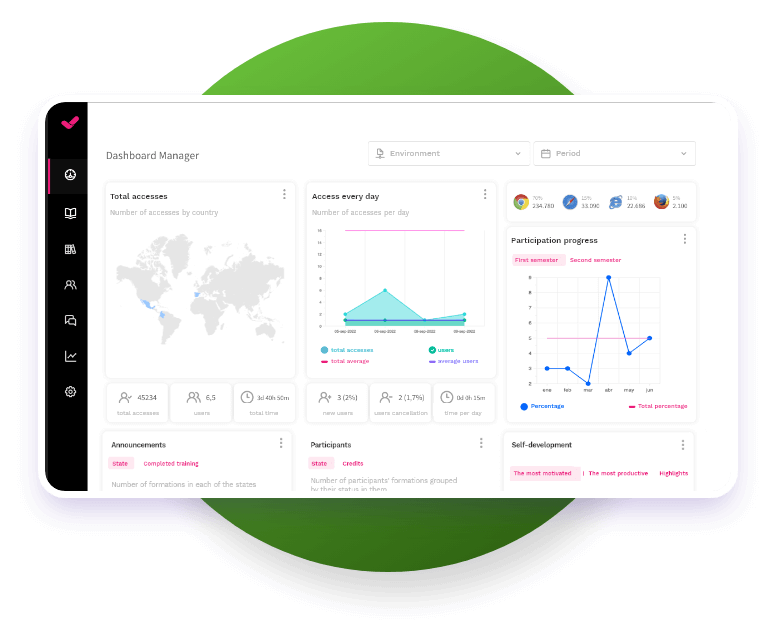Table of contents
ToggleAll the departments that make up a company are equally important, but it could be said that the sales team is the one that has the greatest, most direct impact on financial results and income. For this reason, it’s crucial to provide your salespeople with the tools they need to do their job as effectively as possible. One of the most powerful weapons in your arsenal? Efficient and continuous sales training.
According to a LinkedIn article, commercial teams that have been trained in sales are 57% more successful than those who have not been trained. However, in many cases, training for salespeople can amount to a waste of time that could be better spent prospecting or closing sales. Therefore, when you invest in training, you should be sure that it is truly useful for your business, and has the power to engage and motivate your salespeople.
What is sales training? The answer that every L&D leader needs to know
Sales training, according to Training Industry, is “the personal development of skills and techniques related to creating and exploring new sales opportunities, as well as closing sales for an organization”.
This type of training plays a key role within business development. It’s not simply about passing on basic sales knowledge, but actually equipping your team with the skills and techniques they need to effectively close deals, as well as build lasting relationships with customers.
Why does sales training matter to your L&D strategy?
The most important thing to understand here is that commercial training should not be considered a mere expense, but rather a strategic investment that provides multiple benefits. After all, a well-trained sales team is better prepared to meet market challenges, close more deals, and increase company revenue.
The main benefits of sales training for companies
Targeted and effective sales training has a number of advantages for companies, including the following:
- Develops the skills and knowledge of your sales team, equipping them with the tools they need to better identify and follow leads, forge strong relationships, and close more deals.
- Increases the confidence and motivation of your salespeople, boosting their enthusiasm and commitment to work. This translates into better performance and greater job satisfaction.
- Optimizes sales strategies, allowing you to adapt them to market trends and changing customer needs.
- Reduces the length of the sales cycle, accelerating the process of converting potential customers into real ones.
- Heightens customer retention and satisfaction, creating a shopping experience that helps build customer loyalty and transform them into brand ambassadors.
- Increases the income and profitability of your company, thanks to an increase in sales as well as a reduction of costs stemming from high personnel turnover and inefficiency.
Effective strategies to train your sales team
The world of sales is constantly changing. Techniques that worked yesterday may quickly become obsolete today. Against this backdrop, the key to success is being at the forefront of any trends and patterns. Therefore, in order for your sales training program to be truly effective, you should be sure to implement innovative strategies that keep your team motivated and engaged.
Some of the most effective proven strategies include the following:
Agile training
Agile training has arisen as a strategic response designed to meet the needs of the newest generations of employees. According to the latest research, today’s professionals have increasingly less time to dedicate to extensive training processes. Due to this, there is now a higher value in providing learning content that can be consumed in small doses, through shorter study sessions that generally last between 15 and 20 minutes.
This strategy, known as microlearning, has proven highly effective in business training programs by allowing for the rapid learning – or reinforcement – of specific skills within the work environment.
Gamification and interactive elements
Gamification, and the deliberate inclusion of interactive elements, are both effective strategies for making sales training more engaging, entertaining, and impactful.
Gamification involves integrating game elements, such as challenges, levels and rewards, into the learning process to increase motivation and engagement. On the other hand, including more simple interactive resources and exercises also transforms the learning process into a dynamic and participatory experience.
Training in new technologies
With the rapid evolution of technology and constant emergence of new tools, it’s crucial that professionals acquire the technological skills they need to keep pace. For example, the use of AI is becoming increasingly widespread as a means of boosting productivity within companies. Even in sales teams, 81% of sales leaders say that AI can help them spend less time on manual tasks, according to Hubspot.
Therefore, companies must invest in training programs that teach their employees how to make the best use of these digital tools and technologies. Doing so will help them to improve both their productivity and performance at work.
Key topics that your sales training should cover
However, strategy is not the only thing that matters in successful training. When designing a sales training program, it’s essential to ensure that you cover a range of key topics, including:
- Prospecting and negotiation techniques: these help salespeople to identify and qualify potential clients, as well as learn how to negotiate successful deals.
- Product and company knowledge: ensures that your team fully understands the product or service it is selling, as well as your company’s wider mission and values.
- Market research: this is essential so that sellers understand how to analyze both the market and the competition, identifying sales opportunities and developing effective strategies.
- Consumer behavior: makes it possible to grasp consumer behavior and motivations, and adapt sales approaches more effectively.
- Training in sales skills: it’s essential to provide your team with training in basic sales skills, such as communication, persuasion, and deal-closing. Below, we’ll take a closer look at those skills which are essential in any good seller.
- Training in CRM and other related software: 45% of sales professionals feel overwhelmed by the number of technological tools they are required to use. For this reason, it’s important to provide them with constant training on their use so that they can integrate them into their working routine without becoming overwhelmed.
The key skills of good salespeople
In order to thrive in the competitive business world, your sales executives must possess a set of key skills, which include:
- Effective communication: the ability to communicate clearly, concisely and persuasively is essential to establish good relationships with customers, as well as present products or services to them in an attractive way.
- Active listening: knowing how to listen carefully to customers’ needs and concerns is key to identifying sales opportunities and building lasting relationships.
- Empathy: the ability to place yourself in the customer’s shoes and understand their specific needs is vital to forging an emotional connection and building trust.
- Resilience: knowing how to overcome rejection from a customer (or perhaps several) and then move on is crucial to success in sales, since not every potential buyer will say yes at the first opportunity.
- Results-oriented outlook: successful salespeople are focused on achieving their goals. and always looking for new ways to increase sales.
Where to start? 6 steps to design effective sales training
So far we’ve covered what a sales training plan is all about, what benefits it can provide and what topics it should cover. But how can you design and implement such a plan in your own company? Here are a set of steps to follow:
1. Identify the needs of the sales team
The crucial first step is to conduct an assessment of your sales team’s skills and needs. This will allow you to identify the areas where they need improvement, and focus the training you provide on those elements that will most benefit your team.
In this phase, you should aim to analyze both individual and team performance data, on metrics such as the number of closed sales, average sales value, business cycle duration, and customer retention rate. Look to identify areas where there are performance gaps, or where better results could be obtained.
2. Know your sales team’s profile
In the second stage, you should get to know the strengths, weaknesses, learning styles and preferences of each team member. This will allow you to tailor training to their individual needs, thereby maximizing their levels of participation and learning.
3. Define your training objectives
The next step is to establish clear and measurable objectives for your training. This is essential if you wish to evaluate its success later, and determine whether you are making the desired impact. Ensure that objectives remain specific, achievable, relevant and measurable.
For example, one goal might be to increase sales closing rates by 15% over the next six months.
4. Choose the right tool
Choosing the right training tool or platform for your team can seem overwhelming. Whatever your unique case, be sure to take into account factors such as ease of use, accessibility, and interactivity, as well as monitoring and evaluation features. Whether you’re looking for an e-learning platform, in-person sessions, or a combination of both, make sure that your choice fits the specific needs of your team and your budget.
For example, if you’re seeking to train a sales team within the retail sector, it will help you to have an employee app like isEazy Engage at your fingertips. With this tool, you can easily share microlearning content, which your professionals can then consume from any location through their smartphone.
5. Implement the training
Once you’ve defined your goals, selected the right tool, and developed training materials, it’s now time to launch your program. Keep in mind that it’s best to opt for dynamic and practical training sessions. These will encourage participation and active learning, ensuring that you keep your team interested and maximize results.
6. Evaluate and optimize your training project
Training doesn’t end once it has been implemented. The evaluation phase is just as important as any other since it will allow you to check the results of your training. Through evaluation, personalized monitoring, learning reports and other methods, you’ll be able to determine which aspects of the training worked well and which need improvement. LMS platforms can prove particularly helpful here, allowing you to closely follow the progress of your training.
What are the most common challenges when implementing a sales training plan?
When attempting to integrate sales training, certain obstacles may arise that, if not properly confronted, can negatively affect the impact and profitability of the project. One of the most common obstacles is team resistance, as some professionals may be reluctant to participate in training, perceiving it as a waste of time or even a threat to their work.
Another potential issue is lack of alignment with business objectives, which can hinder acceptance of the program and its effectiveness. If training fails to focus on priority areas of the business, or is simply not in line with the sales strategy, it may not generate the expected results.
Additionally, due to constant, ongoing change in products and markets, keeping content up to date can also become a challenge. For this reason, it is vital to provide ongoing sales training in order to maintain its relevance over time.
Discover more about some of the most effective sales courses
The good news is that if you want to start implementing your sales training plan as soon as possible, then you can do it, with the help of isEazy Skills. From negotiation techniques to effective closings, our catalog of sales training courses will give your sales team the keys to success.
Discover some of our most popular sales courses:
Silences that sell in sales calls
Help your professionals discover how to increase sales by taking advantage of silences and pauses during sales calls.
Social selling to increase your sales exponentially
Thanks to this course, your teams will learn how to get the most out of the latest digital marketing tools.
Sales effectiveness with NLP
Let your team learn the main techniques of neurolinguistic programming to form effective commercial arguments and better connect with customers and their needs.
Get started today: give your team the tools to achieve maximum revenue
Investing in sales training for your team is a strategic decision that can make the difference between success and failure for your company. However, remember that training is not just a one-time event, but rather a continuous process that should respond to the needs of both the market and your company’s strategies. By implementing a comprehensive training program, you can create a highly effective sales force that drives growth and profitability within your organization.
So, are you ready to take your team’s talent to new levels? Request a demo of isEazy Skills today, and start enjoying the most complete catalog of courses on the market, designed to cover any training need.

















